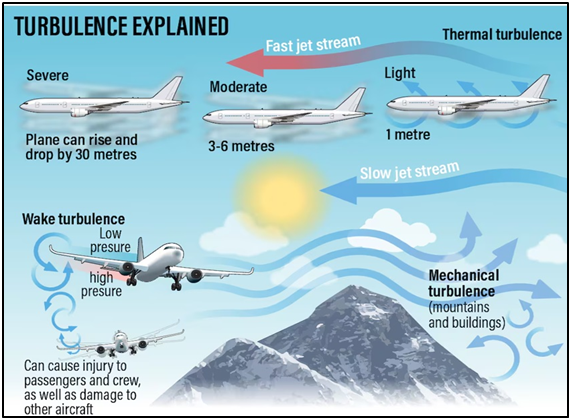Why in News?
A Singapore Airlines flight, from London’s Heathrow Airport to Singapore encountered severe turbulence while over the Andaman Sea/Bay of Bengal near the Irrawaddy Basin, Myanmar.
A passenger passed away and several others suffered injuries of varying degrees.
What’s in Today’s Article?
- What is Turbulence?
- When is Turbulence Dangerous for Aircraft?
- Have Instances of Turbulence Risen and is Climate Change Responsible?
- What can be Done to Avoid Dangerous Turbulence?
What is Turbulence?

- Turbulence is essentially unstable air that moves in a non-predictable fashion. Most people associate it with heavy storms.
- However, the most dangerous type - clear-air turbulence, happens most often in or near the high-altitude rivers of air called jet streams.
- The main cause of such turbulence is wind shear, which occurs when two huge air masses close to each other move at different speeds.
- If the difference in speed is big enough, the atmosphere can’t handle the strain, and it breaks into turbulent patterns like eddies in water.
When is Turbulence Dangerous for Aircraft?
- Aircraft undergo some form of turbulence on a regular basis and pilots are trained to deal with these.
- However, there have been several instances when intense turbulence has brought down modern jetliners.
- Therefore, on the basis of their nature and intensity, turbulence becomes dangerous for aircraft.
- For example,
- A SpiceJet-operated Boeing 737-800 aircraft with 189 passengers encountered severe turbulence in 2022.
- While descending, turbulence was created due to bad weather.
- The airspeed suddenly dropped by around 100 knots, before rising again.
- This led the crew and passengers to rise up (similar to a zero-gravity situation) and fall back down.
- Two passengers were treated for severe head and spine injuries.
- While intense turbulence has been the main cause of an accident, several other factors have contributed to the accident, such as
- Lack of proper training,
- Poor dissemination of weather or wind related information, etc.
Have Instances of Turbulence Risen and is Climate Change Responsible?
- According to a study, clear-air turbulence rose by 55% over the North Atlantic between 1979 and 2020.
- Global warming as a result of greenhouse gas emissions (GHGs) could lead to higher wind speeds in the fastest upper-level jet stream.
- The speeds will increase by 2% for every degree Celsius the earth warms.
- The global temperature has increased by at least 1.1 degrees Celsius since the pre-industrial era and it is expected to increase by 4 degrees Celsius by the end of the century if GHGs continue to rise at the same level.
What can be Done to Avoid Dangerous Turbulence?
- Passengers should
- Listen to instructions from flight attendants;
- Pay attention to the safety briefing at the beginning of the flight;
- Wear a seat belt at all times;
- Use an approved child safety seat or device if a child is under two; etc.
- Airlines should
- Improve dispatch procedures by keeping communication channels open full-time;
- Issue Flight Planning Guidance Charts (FPGs) and Significant Meteorological Information (SIGMETs);
- Include turbulence in weather briefings;
- Promote real-time information sharing between pilot and dispatcher;
- Reinforce the carrier’s turbulence avoidance policy through dispatcher training;
- Consider rerouting using atmospheric modelling and all applicable weather data;
- Using operating procedures and training to prevent turbulence injuries, etc.









